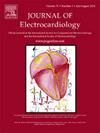Elevated frontal QRS-T angle as a predictor of cardiovascular risk in graves' disease: A comparative study
IF 1.3
4区 医学
Q3 CARDIAC & CARDIOVASCULAR SYSTEMS
引用次数: 0
Abstract
Backgrounds
Graves' disease (GD) is linked to cardiovascular complications, but reliable non-invasive predictors are limited. This study aimed to assess whether the frontal QRS-T (fQRS-T) angle could predict mortality and cardiovascular outcomes in GD patients.
Methods
Initially, we conducted a retrospective analysis of electrocardiogram (ECG) parameters from 291 GD patients compared with 96 healthy controls. GD patients were then categorized based on the presence of hyperthyroid heart disease. Using logistic regression, we identified predictors of cardiovascular outcomes. Subsequently, a retrospective cohort study followed 41 patients with an fQRS-T angle ≥90° and 162 controls over five years, assessing all-cause mortality, ventricular fibrillation (VF) and first hospitalization for heart failure (HF).
Results
Initial analysis showed that a significantly higher proportion of GD patients had an fQRS-T angle ≥90° compared to healthy controls (p < 0.001). Among GD patients, those with hyperthyroid heart disease were more likely to have an fQRS-T angle ≥90° (p < 0.001). Multivariate logistic regression analysis revealed that age, fQRS-T angle, thyroxine (T4), and platelet were independent predictors of hyperthyroid heart disease. In the cohort study, Kaplan-Meier analysis showed significant differences in all-cause mortality or VF (p < 0.001) and first hospitalization for HF (p < 0.001) between the groups. Multivariate Cox regression analyses shown QRS-T angle ≥90° significantly increased the risk of hospitalization for HF (HR 5.04, 95 % CI 2.59–9.81, p < 0.001).
Conclusions
An increased fQRS-T angle may be associated with elevated cardiovascular risk in patients with GD. These preliminary findings suggest that fQRS-T angle could serve as a hypothesis-generating marker for further prospective research.
额骨QRS-T角升高作为graves病心血管风险的预测指标:一项比较研究
格雷夫斯病(GD)与心血管并发症有关,但可靠的非侵入性预测指标有限。本研究旨在评估额位QRS-T (fQRS-T)角度是否可以预测GD患者的死亡率和心血管结局。方法回顾性分析291例GD患者与96例健康对照者的心电图参数。然后根据甲状腺功能亢进性心脏病的存在对GD患者进行分类。使用逻辑回归,我们确定了心血管结局的预测因素。随后,一项回顾性队列研究随访了41例fQRS-T角≥90°的患者和162例对照组,随访5年,评估全因死亡率、心室颤动(VF)和心力衰竭(HF)首次住院。结果初步分析显示,GD患者fQRS-T角≥90°的比例明显高于健康对照组(p <;0.001)。在GD患者中,合并甲亢性心脏病的患者fQRS-T角≥90°的可能性更大(p <;0.001)。多因素logistic回归分析显示,年龄、fQRS-T角、甲状腺素(T4)、血小板是甲状腺功能亢进心脏病的独立预测因子。在队列研究中,Kaplan-Meier分析显示全因死亡率或VF (p <;0.001)和首次住院的HF (p <;0.001)。多因素Cox回归分析显示,QRS-T角≥90°显著增加心衰住院的风险(HR 5.04, 95% CI 2.59-9.81, p <;0.001)。结论GD患者fQRS-T角增高可能与心血管风险升高有关。这些初步发现提示fQRS-T角度可作为进一步前瞻性研究的假设生成标记。
本文章由计算机程序翻译,如有差异,请以英文原文为准。
求助全文
约1分钟内获得全文
求助全文
来源期刊

Journal of electrocardiology
医学-心血管系统
CiteScore
2.70
自引率
7.70%
发文量
152
审稿时长
38 days
期刊介绍:
The Journal of Electrocardiology is devoted exclusively to clinical and experimental studies of the electrical activities of the heart. It seeks to contribute significantly to the accuracy of diagnosis and prognosis and the effective treatment, prevention, or delay of heart disease. Editorial contents include electrocardiography, vectorcardiography, arrhythmias, membrane action potential, cardiac pacing, monitoring defibrillation, instrumentation, drug effects, and computer applications.
 求助内容:
求助内容: 应助结果提醒方式:
应助结果提醒方式:


